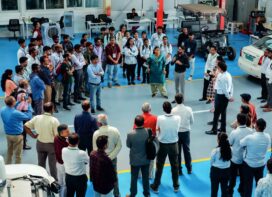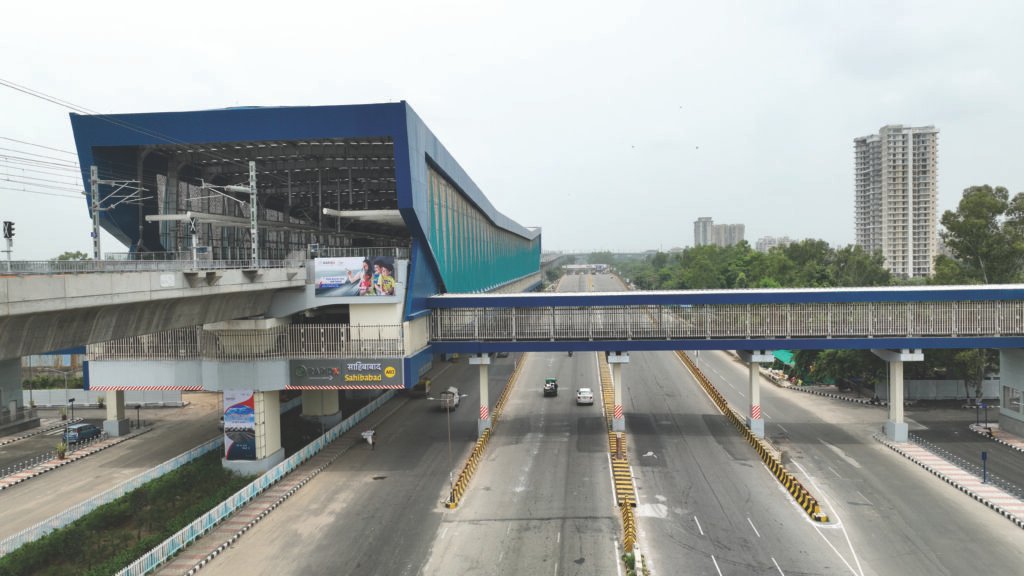
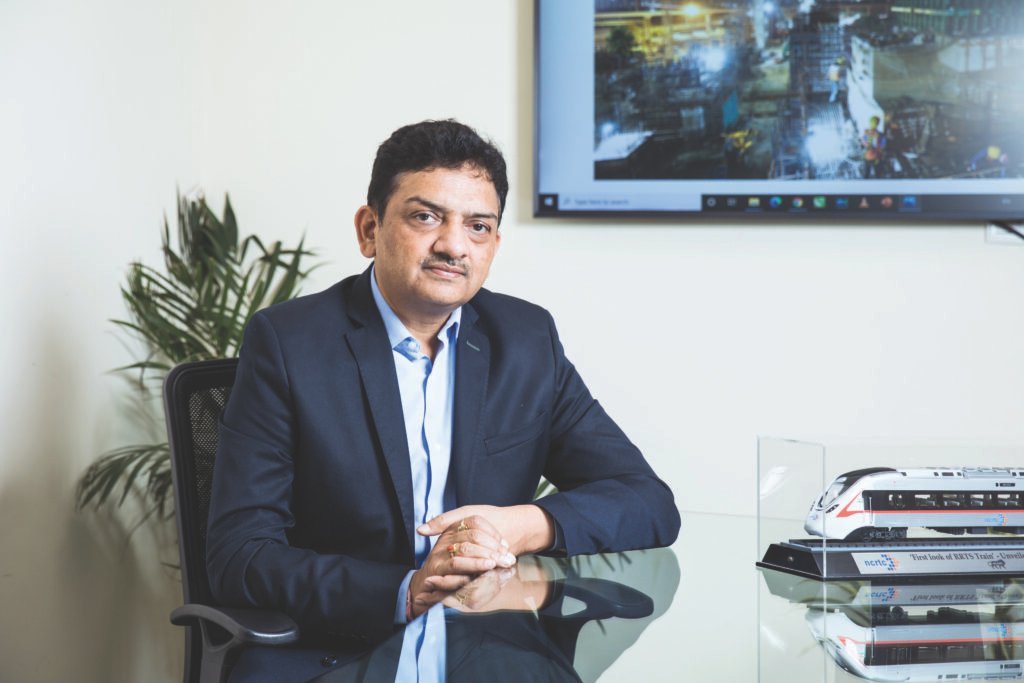 As urban centres continue to expand and traffic congestion becomes a formidable challenge, the conceptualization, design, and implementation of the RRTS has emerged as a pivotal solution. In an exclusive interview, we have the privilege to engage with a true visionary in this field, Vinay Kumar Singh, Managing Director of the National Capital Region Transport Corporation (NCRTC), shares with Jagan Shah, Director of the Artha Centre for Emerging Cities, his experience in orchestrating the paradigm shift called RRTS.
As urban centres continue to expand and traffic congestion becomes a formidable challenge, the conceptualization, design, and implementation of the RRTS has emerged as a pivotal solution. In an exclusive interview, we have the privilege to engage with a true visionary in this field, Vinay Kumar Singh, Managing Director of the National Capital Region Transport Corporation (NCRTC), shares with Jagan Shah, Director of the Artha Centre for Emerging Cities, his experience in orchestrating the paradigm shift called RRTS.
The 17-km long Priority Section of the Delhi-Ghaziabad-Meerut corridor of the RRTS is likely to be inaugurated soon. How does it feel to deliver India’s first regional rapid transit system?
I am pleased that with the full support of like-minded experts within the Government of India and the Indian Railways and numerous departments and agencies working in the NCR, we are creating a national asset that will boost India’s growth and development and be a source of national pride. I am confident that our RRTS will emerge as one of the most popular, economically productive and environmentally-friendly urban mobility systems that the country has ever witnessed. We will also create a model for similar projects in the future.
Starting with the National Capital Region, RRTS is expected to transform rail-based mass transit in India. What are its most significant characteristics?
Apart from providing a safe and reliable commute, improved productivity and quality of life, the other significant characteristics are:
- A design speed of 180 kmph and average speed of 100 kmph. This is the first rapid transit system implemented at the regional level in the country with dedicated infrastructure.
- The operating speed of 160 kmph reduces the travel time considerably within the NCR. Having stations every 5-10 km also means that more areas in the region are connected by the transit system.
- The implementation of RRTS also follows the ‘Comprehensive Action Plan for Air Pollution Control in Delhi & NCR’ and the recommendation of the ‘High Powered Committee on Decongesting Traffic in Delhi’. We expect it will significantly reduce air pollution in the region.
- It has 100% Made-in-India trainsets, lowering the capital expenditure, and uses ETCS (European Train Control System) Level-2 signalling, which enables inter-operability and quick frequency of trains, thereby reducing waiting time for passengers.
- To minimise the maintenance for ballast-less tracks needed for high-speed operations, NCRTC adopted the Austrian precast track technology, regarded as the most superior track systems worldwide. This technology is being implemented for the first time in the country.
- The network ensures seamless integration with the Indian Railways, Inter-State Bus Terminals (ISBTs), Airport and the Metro Rail services, using improved spatial planning and tunnels and viaducts wherever necessary. This will ensure the convenience of quality last-mile connectivity and cater to all categories of travellers.
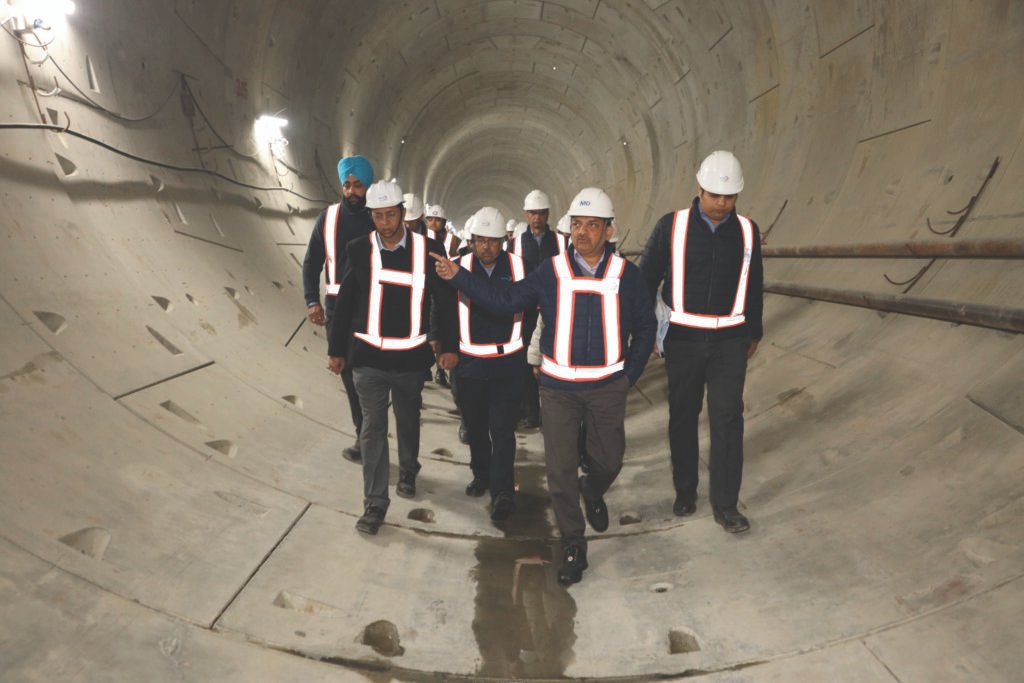
It has only been four years since the construction of the first corridor commenced. What were the key provisions you made to ensure that the construction could progress rapidly and without hindrance?
The implementation of linear infrastructure like RRTS corridors requires a large number of approvals from various regulating/statutory authorities and diversion of utilities that impinge on construction areas. NCRTC took timely action to get approvals for the Delhi-Meerut corridor and the process for the Delhi-SNB (Shahjahanpur-Neemrana-Behror) corridor is at an advanced stage. Better planning and anticipation can ensure uninterrupted project implementation. The major clearances we needed include approval from the Hon’ble National Green Tribunal for constructing the viaduct for the Delhi-Meerut corridor through the Yamuna Flood Plain and approval from the Hon’ble Supreme Court for taking the RRTS through Millennium Park in Delhi.
— The alignment was planned to minimize the construction in dense urban areas and maximise the use of land available with government agencies and the right-of-way afforded on state highways.
– Extensive use of techniques like pre-casting have also helped us in achieving this speed of execution. The majority of RRTS construction is on the median of a busy highway. Pre-casting helped us minimize the in-situ construction, reducing the requirement for manpower, materials and machines and minimising air and noise pollution at the site, while ensuring quality control.
– From the outset, we adopted a Common Data Environment (CDE), a digital platform for all communication and documentation required between NCRTC and its designers, contractors and suppliers, which creates a single source of truth, which improves coordination and obviates dispute.
– The use of Building Information Modelling (BIM), a 3D parametric design technology, reduces time for coordination across technical departments and enables better visualisation of the design and anticipation of the eventual construction, which enhances efficiency and speed.
As a result of all these efforts, in June 2023, a 17-kilometer-long Priority Section of the Delhi-Ghaziabad-Meerut RRTS corridor received approval from the Ministry of Railways and the Commissioner for Metro Rail Safety (CMRS).
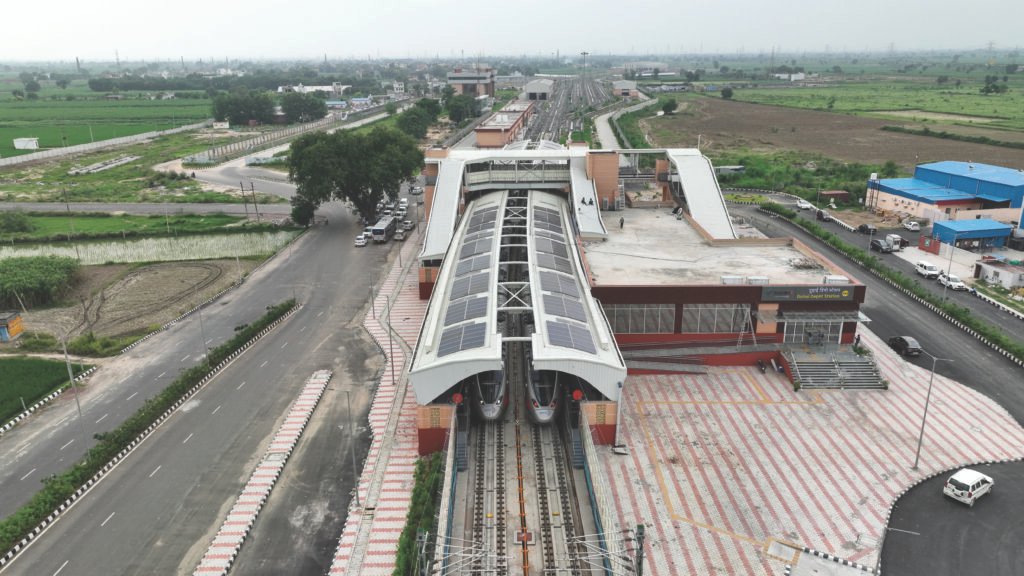
In technological terms, how does the RRTS compare with other global examples such as in Spain, France, and Japan?
Though the concept of RRTS is new to India, high-speed regional rail is a well-accepted solution across the world. A few of the systems which are similar to RRTS include the RER (Réseau Express Régional) in Paris, Crossrail in London, Cercanias in Madrid, Tsukuba Express Line in Japan and GTX in Seoul. While the RRTS draws inspiration from transit systems in other countries, it is also specifically suited to the demands and setting of the National Capital Region of India.
We are building a world-class transport system that uses global best practices to tackle this region’s unique difficulties and potential. For example, energy efficiency is paramount, with modern lightweight car bodies, reliable bogies, and efficient propulsion and braking systems reducing environmental impact, akin to Paris’s RER. The regenerative braking system, like in the Tsukuba Express Line in Japan, recycles energy during braking, enhancing overall efficiency. Similarly, advanced signalling ensures safe and seamless operations, and the QR-code ticketing systems offer integrated solutions for passenger convenience.
How much of the technology, hardware and software used in the RRTS is made in India?
The RRTS is an entirely new project with no precedents in the country. To make this project feasible and to provide the best quality services to the commuters, it was imperative to opt for technologies and practices which are best suited to their requirements. Such advanced design specifications also require improvement in the capacity. Adoption of the Make in India policy will incentivize the manufacture of coaches that run on the 25 KV AC overhead traction systems, that are equipped with regenerative braking system and fitted with comfortable seats, luggage racks and other elements.
Hundred percent of the rolling stock is being made in Savli, Gujarat, with about 80% of the components manufactured locally. We expect that India’s industries and businesses will benefit from this opportunity. The ballast-less track to support a design speed of 180 kmph has neither been used by Indian Railway nor any of the Metro companies in India. The use of the ETCS brings Automatic Train Operation (ATO) over Long-Term Evolution (LTE) radio, a first-of-its-kind integration in the world. The FIDIC contract conditions are vendor agnostic, thereby creating more competition, leading to competitive pricing and easy availability of spares in the future.
We see the RRTS as a network of networks, making sure that we become the backbone for regional connectivity, accelerating the distribution of inclusive economic growth and prosperity across the most populous urban region in the world.
Was there any situation where NCRTC had to develop any technical, financial, or other innovations in-house?
In the initial years of NCRTC, though the primary focus was on getting the projects sanctioned, I felt that it was essential to invest time and effort in building a project management software which has a project owner’s perspective. In the process, we developed a unique capability in the form of an IT tool called Systematic Program Evaluation for Efficient Delivery of Project (SPEED), a cloud-based sophisticated, robust, reliable, and user-friendly platform, which leverages fundamental underlying technological frameworks such as JavaScript, PHP etc. This tool has been of great help during the pandemic as well. It enables project managers to monitor the project based on actual physical progress captured in real time by the field officers. Monitoring is based on planned timelines versus the actual time of every critical activity.
Can you share some ‘green’ or sustainability-related features in the RRTS?
While adopting renewable and sustainable practices, NCRTC has inaugurated a solar power plant at Duhai Depot in Ghaziabad recently, in July 2023. All the buildings in the entire project would adopt and tap solar energy by installing 25,000 solar panels at 25 stations and two major depots in Duhai and Modipuram (Meerut). The solar power plant has an installed capacity of 585 kWp (Kilowatt peak power output), with solar panels installed at various depot buildings and the workshop. It is expected to generate approximately 666,000 units of solar energy per year over its estimated lifespan of 25 years. The plant is expected to reduce CO2 emissions by 615 tonnes per year, contributing to a remarkable reduction of 15,375 tonnes over its lifetime. It positions the Duhai Depot as a ‘Green Depot.’ This achievement of Duhai Depot translates into going beyond ‘Net Zero Carbon Emission’ for auxiliary loads.
What about safety, especially with the speed being 180 kmph?
Since the beginning, Team NCRTC has given the utmost importance to passenger safety. Fire safety and fire-fighting systems have been incorporated into the design of all stations and facilities. Adopting the ETCS Level-2 signalling system, which results in train doors opening and closing simultaneously with the platform screen doors will improve safety.
We are also developing walkways every 2-3km of the entire corridor, for passenger evacuation in emergency. The trains will be monitored regularly by the centralized operations control centre at the Duhai depot. Similarly, the indoor and outdoor surveillance systems and emergency communication system, along with the modern Passenger Announcement and Digital Passenger Information System (PAPIS), facilities, will hugely enhance safety. Maintenance and operational staff will be continually trained to ensure safety and readiness for emergencies.
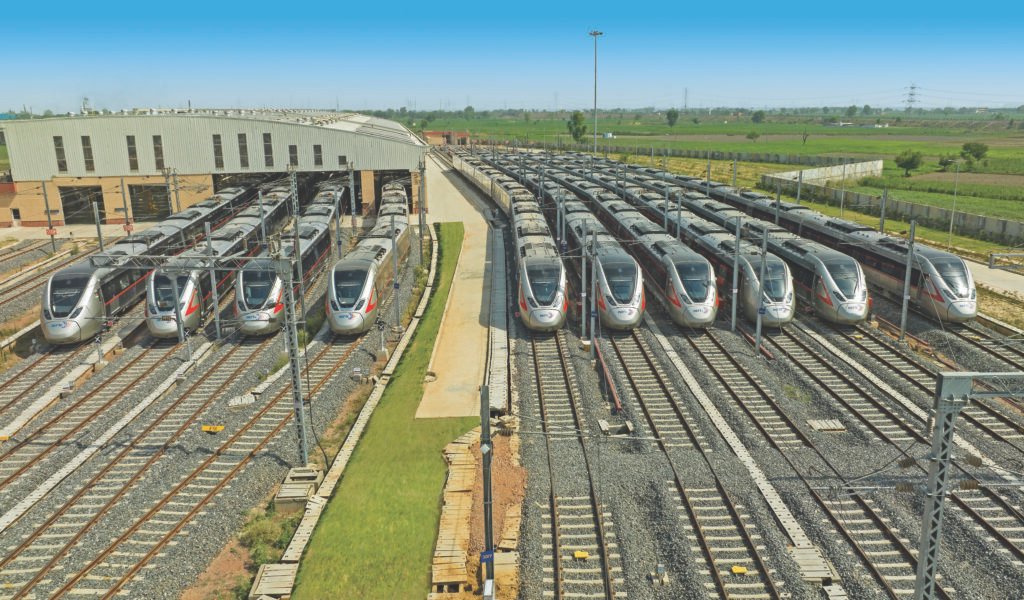
Once the three corridors, connecting Delhi to Meerut, Panipat and Alwar are completed, what will be the regional transit scenario?
Our vision is to ‘Improve the quality of life of people by providing equitable, fast, reliable, safe, comfortable, efficient and sustainable mobility solutions enabling economic development of NCR’.
It is important to note that existing urban transit systems such as Metro and bus systems will complement the RAPIDX services by acting as feeders for commuters’ journeys. In turn, our passengers will use their services. We expect the RRTS to influence the choice of residence, whereby people can live at a distance from the crowded urban areas and benefit from improved quality of life while maintaining easy access to their workplaces. It aims to connect urban, industrial (SEZs/industrial parks), regional, and sub-regional centres to reduce the dependence of commuters on road-based transportation.
Would like to know the experience for people using the system, including the concourses, platforms, and train coaches.
The air-conditioned RRTS trains will offer both Standard and Premium coach options, with a dedicated coach for women commuters included in each train. The train compartments will offer adjustable seating arrangements, complemented by special facilities for passengers who prefer to stand during their journey. RRTS will also feature charging ports for mobile devices, interactive route maps, easy storage for luggage and automatic temperature & lighting control systems. Designated spaces for stretchers and wheelchairs in the train, spacious lifts and stations layouts have been planned to be access-friendly for the elderly and the specially-abled, ensuring universal accessibility.
NCRTC has introduced a two-stage Automatic Fare Collection (AFC) system for Premium Class passengers, requiring validation of the ticket at both the concourse and platform levels to ensure controlled access for Premium users. The ticketing system is compliant with the National Common Mobility Card (NCMC) and will offer digital tickets generated via the RAPIDX Connect mobile application or paper QR-coded tickets generated from ticket vending machines, where passengers can pay using UPI or credit/debit cards or pre-paid cards compliant with the RuPay standard.
If you had the opportunity to transform the entire rail-based transportation system in the country, what would be the three most important things you would like to do?
This is quite a hypothetical question, but if I do get the opportunity, I would focus on three things:
Firstly, I would focus on seamless integration with other modes of transport at all stations. An integrated multi-modal network would connect trains, buses, metro, trams, and even last-mile alternatives such as bicycles and ride-sharing services, requiring well-designed interchanges and terminals that allow for seamless transitions across modes, saving travel time and improving the overall commuting experience.
For this, we will need to do advanced planning for integration of networks, and adopt unified ticketing systems and automatic fare collection systems across the board. I believe this is something that all travellers in India are demanding and that will enhance their economic productivity.
Second, I would focus on augmenting the infrastructure to increase the throughput of passengers as well as freight. The optimisation of flows in an integrated multi-modal network, with railways at the core, will require using advanced data analysis and modelling to identify the bottlenecks and to find resolutions of the blockages and complications for each one separately as well as a network. While advanced analytical and planning techniques will be at the core, bringing on board the operational insights acquired by experienced veterans will be priceless.
The third priority will be satisfying the requirements of customers, both passengers as well as operators of freight. This will require the judicious use of technology as well as better understanding of user needs.
I believe that if we can achieve these three– multi-modal integration, enhanced flow and improved convenience – then India will have the best rail-based transportation system in the world.
Please tell us about the organisation you have built over the past five years. How did you create world-class teams of professionals?
I have envisioned a truly technology-driven, lean and mean organisation of professionals having all the core values that we espouse at NCRTC: integrity, collaboration, ownership, customer focus and continuous learning. These values are the cornerstones of the organisation we are building, and they evolved from a visioning exercise that we conducted together with all the employees.
These values have become so embedded in the organisation that they inform every choice we make. Even when we are recruiting new members for Team NCRTC, we sometimes give greater emphasis to the values than to the competencies, because an individual develops the competencies that are required in a particular context. Our organisation must have the right culture, where we have mutual respect and trust and we are not simply deferential to authority. Only then can we adopt the “commuter-first” attitude, where we cater to our customers in all respects.
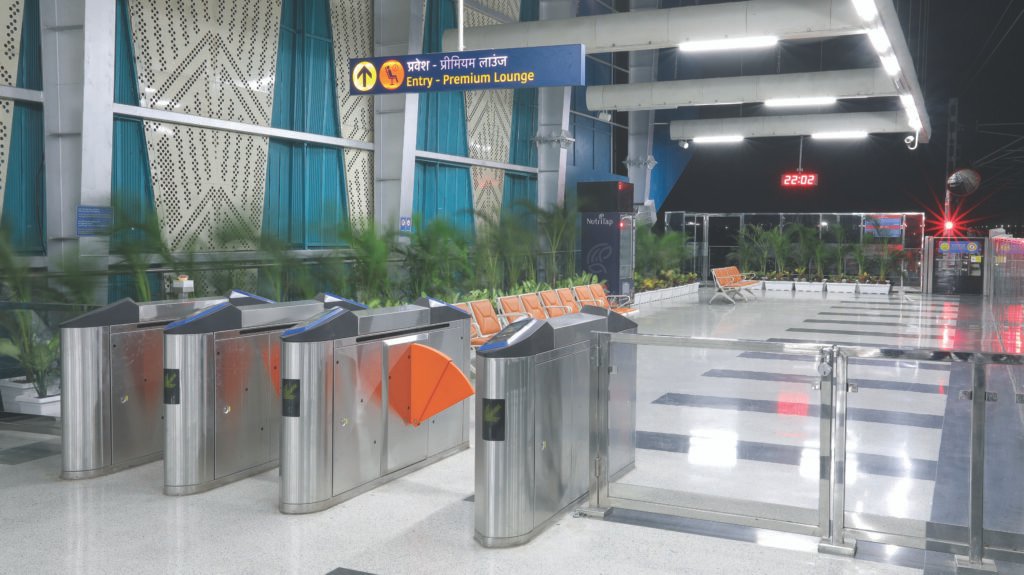
 TrafficInfraTech Magazine Linking People Places & Progress
TrafficInfraTech Magazine Linking People Places & Progress

